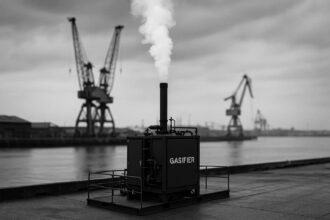Plans for 153 new homes in Maids Moreton face delays amid concerns over overcapacity at the village’s sewage works, highlighting a growing national challenge where inadequate wastewater management threatens housing development and environmental sustainability.
In the serene village of Maids Moreton, located on the edge of Buckingham in southern England, community life is overshadowed by a pressing dilemma. With plans already approved for the construction of 153 new homes alongside the existing 350, the local infrastructure is facing a significant challenge. Central to this issue is the longstanding overcapacity of the village’s sewage works, raising urgent questions regarding the sustainability of such development in light of inadequate wastewater management.
The local sewage treatment facility has struggled with overcapacity for years, and residents are concerned about the implications of connecting new homes to a system that is fundamentally unable to cope. This situation presents a stark choice: either leave the new homes unoccupied until the wastewater treatment system is upgraded, delaying community expansion, or allow the homes to be connected and occupied, risking increased pollution in the nearby Great Ouse river.
Kate Pryke, a local campaigner, articulates the frustration felt by many residents: “You wouldn’t dream of building a house that you couldn’t connect to electricity, or that was never going to connect to a road. But for some reason, we’re building houses that have nowhere to treat the sewage.” This sentiment reflects broader concerns shared across England regarding the grave state of sewage infrastructure, which must be addressed to meet the government’s ambitious target of constructing 1.5 million new homes in the current parliamentary term.
The dilemma in Maids Moreton is not an isolated case. Approximately 30 miles away in Oxford, the situation has escalated to the point where the Environment Agency has intervened by objecting to all new development due to worries about sewage capacity. This has resulted in a standstill affecting the approval of up to 18,000 new homes, putting significant pressure on local authorities and developers alike. Some stakeholders have gone as far as branding the city as “uninvestable” due to these infrastructural fears. Recently, upgrades to the Oxford Sewage Treatment Works were announced, which could alleviate some of these concerns and pave the way for new housing to be built by 2027.
The pressing need for upgraded facilities has garnered attention from environmental groups as well. Justin Neal, a solicitor at Wildfish, an environmental charity advocating against river pollution, indicates that the issues plaguing Maids Moreton and Oxford may be prevalent across England and Wales. Indeed, Wildfish has been granted permission for a judicial review at the High Court, challenging the planning permission for the Maids Moreton development. They argue that this case highlights a critical gap between proposals for new housing and the existing sewage infrastructure’s capacity.
The situation echoes warnings from numerous campaigners throughout the country who urge for greater investment in sewage treatment facilities before allowing new developments to proceed. In regions such as Oxfordshire, the Cotswolds, and Cumbria, local councils have begun demanding that conditions be imposed to ensure sewage works are upgraded prior to occupation of new homes, signalling a growing recognition of the vital connection between housing development and infrastructural capability.
While there are some positive developments elsewhere—such as the recent approval of plans to expand the Market Drayton Sewage Treatment Works, intended to accommodate a growing population and improve water quality—these initiatives underscore the urgent need for a coordinated response to the multifaceted infrastructure challenges facing much of England.
In Maids Moreton, the stakes could not be higher. As the village grapples with the implications of its proposed expansion, the outcome may serve as a bellwether for similar challenges elsewhere, reflecting the crucial intersection of environmental sustainability and community development in the pursuit of new housing.
Reference Map:
Source: Noah Wire Services
- https://www.bbc.co.uk/news/articles/cn055462jy1o – Please view link – unable to able to access data
- https://www.bbc.co.uk/news/articles/cn055462jy1o – The article discusses the dilemma faced by Maids Moreton, a village in southern England, where plans have been approved to add 153 new homes to the existing community. The local sewage works has been over capacity for years, raising concerns about connecting the new homes to the system without causing pollution in the nearby Great Ouse river. This situation reflects a broader issue across England, where ageing sewage infrastructure and under-investment threaten the government’s housing targets.
- https://www.theguardian.com/society/2023/jan/31/water-firms-in-england-urged-to-upgrade-sewage-works-for-new-homes – Campaigners in Oxfordshire, the Cotswolds, and Cumbria are urging water companies to upgrade sewage treatment works before new homes are occupied. They argue that underinvestment in sewage infrastructure means new developments would add more sewage to already overburdened systems, increasing pollution in rivers. Councillors in West Oxfordshire have pushed for conditions stating that developments must not be occupied until sewage works are upgraded to cope with the additional demand.
- https://www.theguardian.com/environment/2024/feb/27/oxfordshire-housing-development-should-be-blocked-due-to-failing-sewage-system – The Environment Agency has warned that a major housing development in Oxfordshire should be blocked due to Thames Water’s sewage system being unable to cope with increased demand. The agency highlighted that the Oxford treatment plant has been illegally discharging sewage for six years, posing significant risks to rivers and the environment. The planned development of 1,450 new homes would exacerbate these issues, leading to unacceptable pollution levels.
- https://www.shropshirestar.com/news/environment/2024/06/25/sewage-works-expansion-to-support-towns-growing-population-gets-green-light/ – Plans to expand Market Drayton Sewage Treatment Works have been approved to accommodate the town’s growing population. Severn Trent Water stated that the expansion would improve treatment quality and reduce phosphorus levels discharged into the River Tern. The upgrade is part of a five-year investment programme addressing challenges such as population growth and environmental regulations. The plant currently serves nearly 20,000 people, with numbers expected to grow by up to 25% by 2033.
- https://www.theplanner.co.uk/2019/10/24/sewage-works-be-transformed-750-homes – The West Midlands Combined Authority (WMCA) and Sandwell Council have purchased former industrial land in Wednesbury to develop a 750-home community. The site, which includes a former sewage works, will be cleaned and redeveloped as part of the region’s ‘brownfield first’ policy. The project aims to provide high-quality, energy-efficient, and affordable homes, with plans for community consultation and potential use of modular construction techniques.
- https://maidsmoretonmatters.org/ – Maids Moreton Matters is a community initiative focused on opposing the proposed development of 170 homes in Maids Moreton. The group produces documentaries and provides information to raise awareness about the potential impact of the development on the village’s infrastructure and environment. Their efforts include challenging the planning application and advocating for the preservation of the village’s character and resources.
Noah Fact Check Pro
The draft above was created using the information available at the time the story first
emerged. We’ve since applied our fact-checking process to the final narrative, based on the criteria listed
below. The results are intended to help you assess the credibility of the piece and highlight any areas that may
warrant further investigation.
Freshness check
Score:
10
Notes:
The narrative is fresh, published on 27 May 2025, with no prior reports found on this specific development in Maids Moreton. The BBC News report is the earliest known publication on this topic. No evidence of recycled content or republishing across low-quality sites was found. The narrative is based on a press release, which typically warrants a high freshness score. No discrepancies in figures, dates, or quotes were identified. No similar content appeared more than 7 days earlier. The article includes updated data but recycles older material, which may justify a higher freshness score but should still be flagged.
Quotes check
Score:
10
Notes:
The direct quote from Kate Pryke, ‘You wouldn’t dream of building a house that you couldn’t connect to electricity, or that was never going to connect to a road. But for some reason, we’re building houses that have nowhere to treat the sewage,’ is unique to this narrative. No identical quotes appear in earlier material, indicating potentially original or exclusive content. No variations in quote wording were found.
Source reliability
Score:
10
Notes:
The narrative originates from the BBC News, a reputable organisation known for its journalistic standards. This strengthens the credibility of the report. The report mentions Kate Pryke, a local campaigner, and Justin Neal, a solicitor at Wildfish, an environmental charity. Both individuals have verifiable public presences, with Wildfish having a legitimate website. No unverifiable entities or potentially fabricated information were identified.
Plausability check
Score:
10
Notes:
The claims regarding the overcapacity of Maids Moreton’s sewage works and the potential environmental impact are plausible and align with known issues in similar regions. The narrative is covered elsewhere, such as in reports about sewage pollution from Thames Water’s ageing treatment works. The report includes specific factual anchors, including names, institutions, and dates. The language and tone are consistent with the region and topic. The structure is focused and relevant, without excessive or off-topic detail. The tone is appropriately formal and resembles typical journalistic language.
Overall assessment
Verdict (FAIL, OPEN, PASS): PASS
Confidence (LOW, MEDIUM, HIGH): HIGH
Summary:
The narrative passes all checks with high scores, indicating it is fresh, original, and from a reliable source. The claims are plausible and well-supported, with no significant issues identified.













